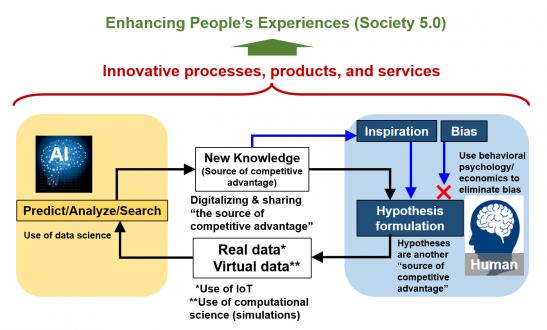TOP > LEARN > AI Technology
 AI Technology
AI Technology
HAICoLab
We introduce HAICoLab,* the AI utilization concept conceived by Yokohama Rubber Co., Ltd., as part of its effort to promote digital innovation. HAICoLab builds upon two previous Yokohama Rubber AI-based materials development technologies, a highly precise multi-scale simulation technology and a material informatics technique, to which the company has added a unique AI-based framework that focuses on human characteristics.
* An acronym for Humans and AI ColLaborate for digital innovation. It also has the meaning of a laboratory for joint research by humans and AI.
AI is an abbreviation of artificial intelligence, which is a type of computer software now being used in such applications as autonomous driving and automated recognition to make advanced and intelligent observations and decisions similar to those made by human beings. For a computer to achieve the recognition and decision-making capabilities of a human being, it must use AI software that provides it with a huge amount of training data. This technology is often called “machine learning”, which becomes “deep learning” when taken to the next level. The use of AI is being propelled by advances in computer technology that have made it possible for computers to process larger amounts of data than can be handled by the human brain. AI can also be used for research and development of tires and rubber materials. R&D on tires and related materials requires predicting the effect of new ideas (design factors) and discovering which design factors realize the required properties. In addition, understanding the relationship between design factors and their effects (mechanisms and causal relationships) facilitates tire R&D and product development. AI is a means to this end.
The objective of R&D at Yokohama Rubber is to develop innovative technologies. There are two kinds of innovation. The first is incremental innovation (i.e. exploration) that amounts to refining existing technologies. The second is radical innovation (i.e. exploration), which is based on new ideas that are completely different from existing technologies. Incremental innovation and radical innovation use different data domains to be targeted by AI. Incremental innovation applies AI that uses existing data is its training data. However, existing data alone is insufficient for radical innovation. In other words, radical innovation requires the use of data from previously unexplored domains. Accordingly, one cannot aim for radical innovation only by using AI. Yokohama Rubber’s HAICoLab concept aims for disruptive radical innovation by aggressively using simulations to accumulate data from previously unexplored domains and then orchestrating a “human and AI concerto” that combines human inspiration with AI technology. HAICoLab also aims to eliminate the biases that negatively affect people’s decision-making when using AI, such as confirmation bias and usability heuristics. Yokohama Rubber aims to use HAICoLab to create innovative processes, products and services that will enhance people’s experiences and contribute to the realization of "Society 5.0", the Japanese government’s initiative to create a future society that will make full use of innovative technologies such as AI and IoT.
A key feature of HAICoLab is its merging of human inspiration and creativity with AI’s enormous data processing capability to foster new discoveries and digital innovation. By creating and collecting data (real data generated by the IoT and virtual data from simulations, etc.) based on hypothetical conditions set by humans, and then using AI to predict, analyze and search, Yokohama Rubber will be able to acquire new knowledge. Hypothesis formulation uses behavioral psychology and behavioral economics to consciously eliminate biases such as preconceptions that are barriers to new discoveries. In addition, the knowledge obtained becomes memory fragments that can be combined to create new ideas (inspiration). By eliminating bias and formulating hypotheses based on inspirations, Yokohama Rubber aims to seek new knowledge in previously unexplored domains.
Yokohama Rubber already is using HAICoLab to develop rubber materials for use in its development of new products. Expanding the use of HAICoLab to a wider range of applications and developing new technologies based on this concept will support Yokohama Rubber’s development of new and unique products.
<HAICoLab conceptual diagram>


